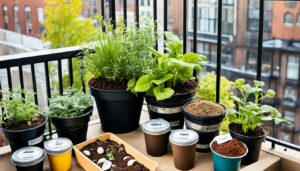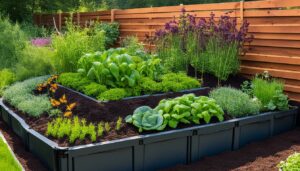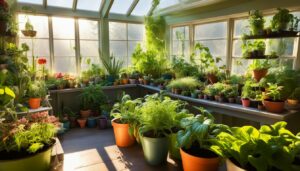In the sprawling world of agriculture, a staggering 70% of the crops we grow rely on the help of beneficial insects for pollination and pest control. Yet, the age-old practice of “companion planting” might just be nature’s best-kept secret for bolstering these invaluable insect allies and forging natural pest control methods in our gardens. Far from a simple gardening fad, companion planting embodies years of organic gardening tips and tricks that savvy green thumbs utilize to keep pest populations in check, naturally.
Beyond its effectiveness in creating a harmonious habitat for beneficial insects, companion planting is proven to be a potent form of defense against the monoculture pitfalls that so often plague commercial agriculture. By weaving variety into the very fabric of our gardens, we craft ecosystems that confuse and counteract the efforts of pests looking for their next meal. This approach isn’t just about planting a few extra varieties; it’s about understanding and implementing biodiversity as a cornerstone of sustainable cultivation.
Key Takeaways
- Companion planting is a strategic approach integral to organic gardening for natural pest control.
- A diverse array of plants can prevent pest infestations by disrupting their patterns and making it harder for them to locate crops.
- This method supports beneficial insect populations that naturally mitigate pest issues.
- Organic gardening tips often revolve around companion planting due to its non-toxic, environmentally friendly pest control benefits.
- While companion planting offers many advantages, understanding individual crop needs and interactions is key to its success.
- Implementing companion planting strategies can lead to reduced pesticide use, contributing positively to the ecosystem and crop yields.
Understanding Companion Planting and Its Benefits
Incorporating organic gardening strategies into our daily lives enriches not only our gardens but also our environment. The time-tested technique known as companion planting remains a fundamental component in crafting a thriving and sustainable garden space. This method, which features prominently in any thorough plant companion planting guide, is not merely about placing plants together in a space; it is the art of creating plant communities, which champion mutual benefits and ecological harmony.
Critical to sustainable gardening practices, companion planting offers a diversity of rewards:
- Natural Pest Deterrence: Certain plant combinations can effectively mask the chemical cues that attract pests or even repel them outright, thus reducing the need for chemical interventions.
- Improved Plant Health: Companions aid in overall plant growth by enriching the soil, providing shade, or supporting water retention.
- Economic Advantages: Companion planting can yield an economic return through the secondary harvest of companion plants or even through indirect means, like better main crop protection.
Despite the anecdotal and historical success stories regarding companion planting, scientific validation of these methods is a pursuit that faces challenges. Yet, the quest for empirical evidence to support these practices continues, as traditional knowledge dovetails with modern research efforts in agronomy.
Companion planting is not just a method, it is a philosophy that fosters a closer relationship between the gardener and the garden. Through observation and experimentation, gardeners become scientists in their own right, learning which plants perform best side-by-side. Here are a few examples of well-known companion pairs:
- Tomatoes with basil for improved flavor and insect deterrence
- Marigolds with vegetables to protect against nematodes
- Cucumbers with sunflowers as natural trellises
We are reminded through companion planting that our gardens are more than the sum of their parts. By following the guidelines of a plant companion planting guide, we enter into a collaborative relationship with plants, encouraging a balanced, productive, and organically rich garden ecosystem.
Companion Planting, Natural Pest Control, Organic Gardening Strategies
Embracing companion planting benefits is integral to crafting a flourishing organic garden. Leveraging tactics that foster beneficial insect management and natural pest deterrents can create harmonious garden ecosystems robust against invasions by unwanted visitors. Through the strategic pairings of plants, gardeners can employ organic gardening techniques that serve hand-in-hand with nature’s own pest control methods.
The Science Behind Plant Synergies
Facilitating plant synergies within the garden landscape is a cornerstone of sustainable gardening practices. By understanding the complex relationships between flora and fauna, one can optimize organic pest control methods. The introduction of certain plant species can effectively camouflage or repel pests through sensory disruption, safeguarding your main crops without the need for chemical interventions.
Selecting Companion Plants for Effective Pest Management
Selecting the right companion plants is a strategic decision in any organic gardening guide. It’s all about creating a supportive environment that acts as a natural pest control, while also catering to the primary crops’ nutritional and environmental needs for light and soil conditions. Beneficial flora such as marigolds, garlic, chives, and mint can enhance your garden’s defense against pests, while also improving soil health and inviting a community of predator insects.
Case Studies: Success Stories in Companion Planting
Real-world examples underline the power of companion planting. Gardens across the nation have seen the beneficial insect management that follows when certain plants re-route pests or provide a habitat for natural enemies. Whether it’s alfalfa protecting cotton or early potato varieties warding off beetles, these strategies have made pronounced impacts, corroborating companion planting’s benefits within diverse agricultural ecosystems.

| Companion Plant | Main Crop Protected | Pest Managed | Beneficial Insect Attracted |
|---|---|---|---|
| Marigold | Tomatoes | Nematodes | Ladybugs |
| Garlic | Roses | Aphids | Hoverflies |
| Chives | Carrots | Carrot Fly | Parasitic Wasps |
| Mint | Cabbage | Cabbage Moth | Tachinid Flies |
Conclusion
In the world of organic gardening, companion planting emerges as a vital strategy for promoting natural pest control and fostering an environmentally balanced garden. This practice, deeply rooted in permaculture principles, emphasizes the benefits of plant diversity for a more resilient ecosystem. Through attentive garden planning, organic gardeners can skillfully arrange companion plants, which in turn serves to disrupt the presence of invasive pests and attracts beneficial insects, resulting in a more vigorous and flourishing garden space.
The notion that a diversity of plants can lead to lower pest numbers holds sway in the gardening community, bolstered by a growing body of scientific support. While research into companion planting continues to advance, the anecdotal and empirical successes shared by gardeners underscore its effectiveness. For those wishing to cultivate their own thriving organic oasis, a wealth of organic gardening tips and a comprehensive companion planting guide are indispensable tools. These resources assist gardeners in integrating plants that complement one another, both in form and function, ensuring that sustainable gardening practices are not only espoused but also successfully implemented.
Ultimately, the push towards a garden devoid of synthetic pesticides is a collective journey. Gardeners, both novice and seasoned, are encouraged to pilot various herb, flower, and cover crop combinations to discover which partnerships work best in repelling the specific pests they face. Embracing this hands-on approach to sustainable gardening practices contributes to a garden’s overall health and yields without relying on harmful chemicals. The result is an organic garden that elegantly balances ecological integrity with horticultural productivity, a goal well within the grasp of green-thumbed enthusiasts everywhere.








